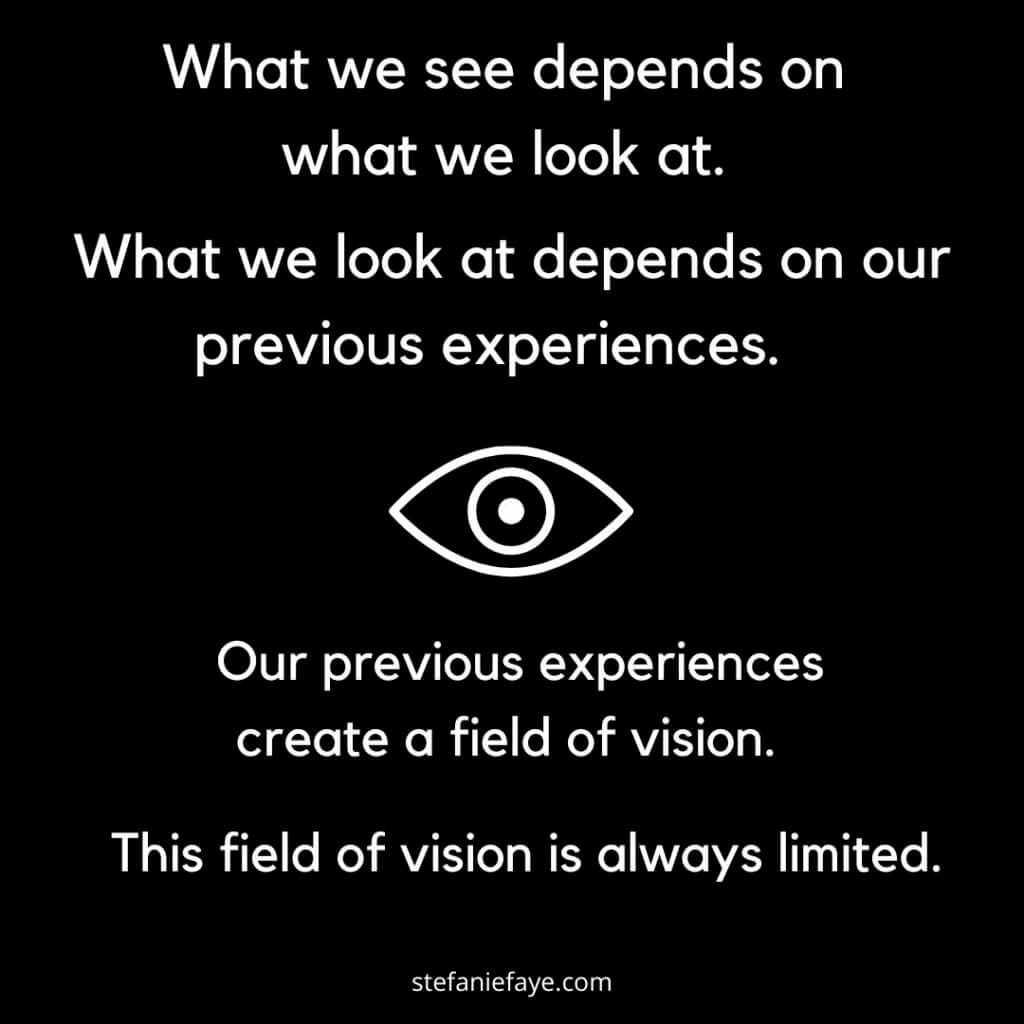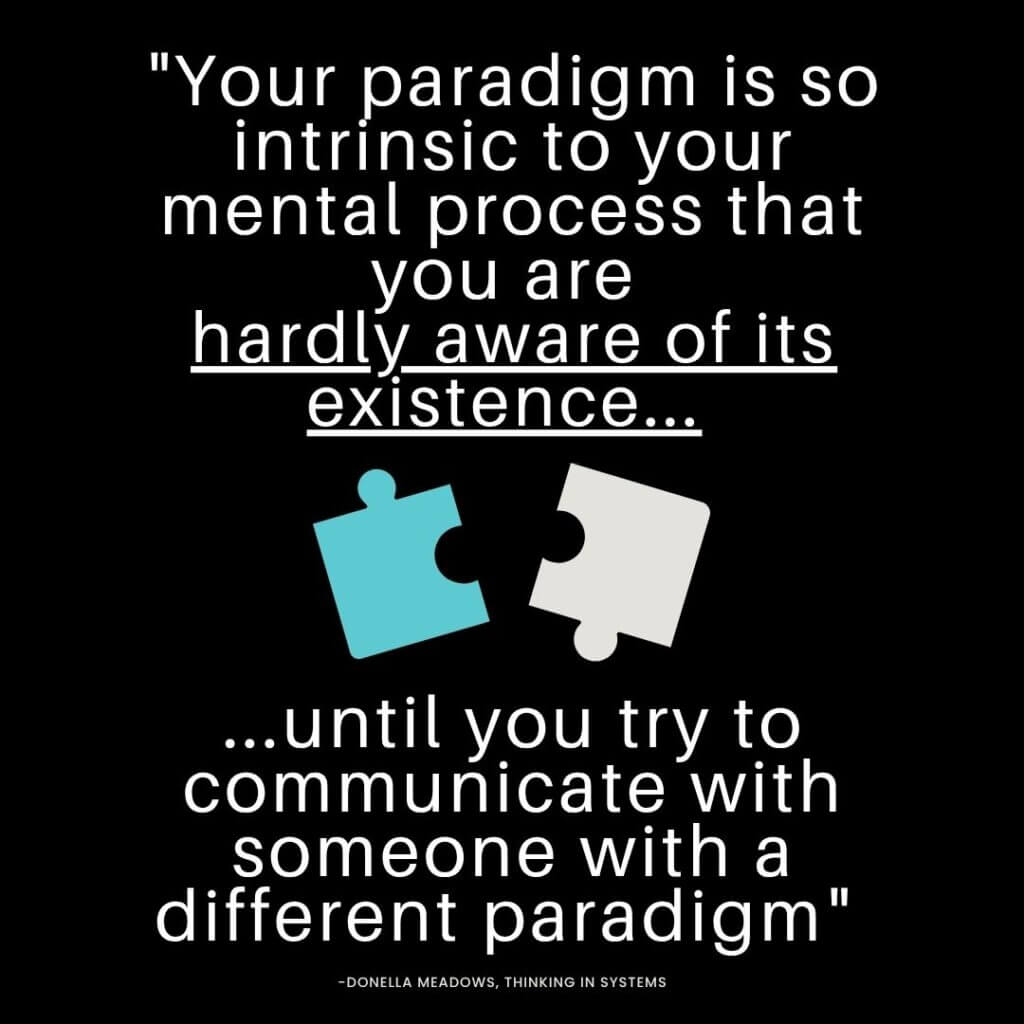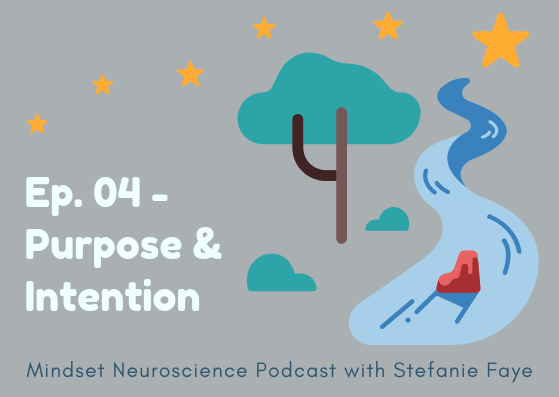"Your paradigm is so intrinsic to your mental process that your are hardly aware of its existence, until you try to communicate with someone with a different paradigm"
-Donella Meadows
Our past creates predictions. These predictions form our MINDSET.
Current neuroscience research* asserts that one of the main functions of the mind-brain-body’s is to make predictions.
It does this by using our past to make assumptions about what’s happening now. Another word for these ‘assumptions’ are ‘predictive models’.
The mind-brain-body creates predictive models by taking snippets of information and then creating models that it uses to predict lots of things without needing to have all the information of everything it comes across. it would be way less efficient if it had to analyze everything in order to understand it.
These predictive models affect our relationships, behaviors, and even our emotional well-being.
One way these predictive models influence our relationships and how we interact with people is that they prevent us from seeing people and events as they actually are.
Instead, we're seeing them through our model - or paradigm - that's built from our history. Most of our predictive models about everything from how we respond to mistakes, failure, rejection, perceived rejection, neutral facial expressions, eye gaze (the list goes on…) all started with the very beginning of us.
Our first environments surrounded us with vibrations including how the people around usreacted (and sent out vibrations through their voices, words, facial expressions, approach/avoid behaviors, etc.). The environments also included opportunities to learn and explore our own strengths, sensitivities and challenges in ways that were supportive and empowering, or restrictive and anxiety-producing.
Our predictive models and mindset about relationships were also influenced by the vibrations of the people around us: how they reacted and responded to us.. how they reacted to our cries, our giggles, our demands, and our needs.
And all of that started (and continues to build) a predictive modeling process for you.
Your brain-body used the data it had to figure out how to predict human behavior. It uses (and continues to use) a very small sampling of data from only a few select people in your world. So many of the statistics, and assumptions and computations that your brain is using NOW were created back THEN.
And they are all based on a very small sample of data.
The interactions from your past were affected by the stress levels, maturity levels, of your caregivers, and how they were able to respond to you. (which was also affected by their caregivers, etc. etc.).
These predictive mindsets also often lead us to filter data in ways that keep us responding to people and events in repetitive ways. Our current environments and social interactions continue to feed into these predictive algorithms and mindsets.

Because we each have different histories, we all have different filters.
I will therefore never see a person or situation the same way as another person sees it. My senses are going to filter how I perceive someone or something based on all of my associations I have from my past experiences. and so will you.
So what we see is that we are never really dealing with the same reality.We are responding to the version of events and people that are filtered through our predictive models.
Luckily, despite the influence of our past, the human brain is capable of change.
The first step in this transformation is awareness. When we recognize that our reactions may be rooted in the past, and that we might be missing something from our perspective, we allow our brain to open us up to new possibilities.
This is because simply becoming aware that we have a mindset about something activates NEW NEURAL CIRCUITRY. There is brain activity that relates to becoming aware of ourselves and our responses. Stanislas Dehaene calls this our 'global conscious workspace':
“When we say that we are aware of a certain piece of information, what we mean is just this: the information has entered into a specific storage area that makes it available to the rest of the brain"
-Stanislas Dehaene, Consciousness and the Brain
An interesting example of this comes from Donella Meadows’ Thinking in Systems (p.109):
During the oil embargo and energy crisis of the early 1970s, the people in the Netherlands started paying closer attention to how much energy and electricity they were using. It was discovered that some houses in a particular subdivision were using one third less electricity than the other houses. No one could explain why… They all had similar families and were being charged the same price for electricity.
It turns out that the difference was where the electric meter was located. Some houses had been built with the meter in the basement, with others having the electric meter in the front hall. The houses with the meter in the front hall were able to see the little wheel turning around, adding up the monthly electricity bill many times a day.
This is a demonstration of how increasing our field of awareness helps us become more aware of our own habits and patterns. And this increased awareness of our patterns can significantly impact our behavior.
The more possibilities we have for understanding what is happening, the more we have a chance of updating and expanding our thought-action repertoires.
In my own work, the moments where I have seen people transcend into an entirely new set of behaviors and clarity have come from a moment in time - a connecting of dots that form a new perspective. This new perspective is then followed by new behaviors that align with the updated perspective or logic model.
These moments were about an expansion of their awareness as to why they felt or behaved the way they did. Their previous logic model of why things were the way they were was updated or replaced by something bigger and more expansive. Interestingly, many of these experiences were also captured by brainwave data that reflected, gamma brain waves – these are brain waves known to be associated with a synchronized firing of many different networks, all at once, and potentially also the connection of networks that have not been connected before.
These experiences led me to use the idea of expanding our awareness as the true essence of what we mean by a paradigm or mindset shift. We don’t blind ourselves to the previous perspective. Rather, we zoom out our awareness to see what is faulty or missing from a perspective, and include more systems and nodes of data that feed into our field of awareness as to why something (or someone) is the way it is.
A mindset is a way of seeing.
It is directed by electrochemical firing patterns in the brain that we've used repeatedly. Those patterns direct what we pay attention to, what we notice, how we believe the world operates.
These patterns develop in large part based on the mindsets of people around us - how they talk about whether change is possible, whether people are the way they are and there's nothing that can be done.. or whether they see things as changeable and upgrade-able.
We can update those firing patterns by becoming aware of the paradigms and mindsets we are surrounded by and that we use to guide our life... and then making the conscious choice to surround ourselves with paradigms and mindsets that help us feel better and more empowered. We can do this through courses, books, choosing a diverse range of information, and nurturing connections and friendships that help us feel like we are operating within the best version of ourselves.
With the power of the human brain we can expand our mindsets by expanding our field of awareness.
Will a change in mindset forever fix a person’s problems? NO! We are too complex for one simple solution, and we are forever launching into new challenges.
BUT… The power of a mindset shift is that it sparks an awareness that a shift in perception CAN happen, and that shift in and of itself creates internal, attentional changes that lead to new experiences.
I'll be sending a few more articles about the neuroscience of mindset over the next couple of weeks - AND… we'll explore a very special type of mindset - the Super-Regulator Mindset - in my FREE Mindset Neuroscience Workshop 🙂



